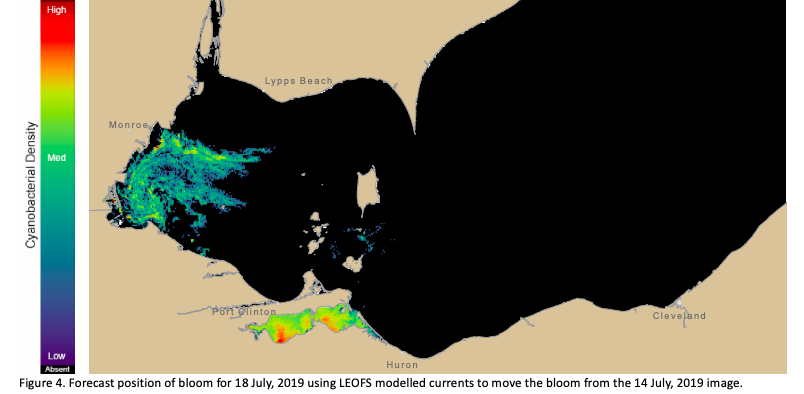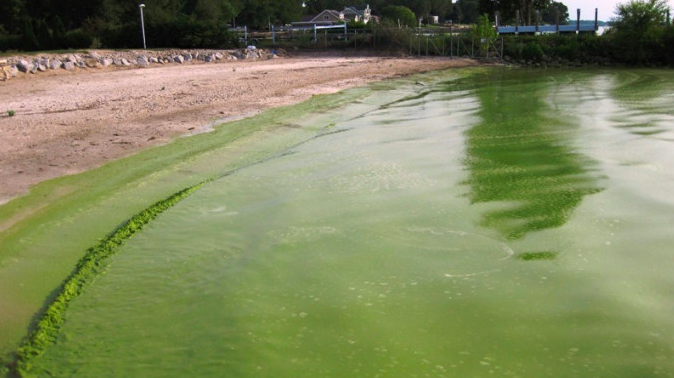
Image: NOAA HAB Forecast page
As has happened every year since 2002 starting in mid-July, a sizeable and harmful algal bloom has now formed in the Western Basin of Lake Erie, and NOAA on Monday issued a bulletin that the bloom “extends from Maumee Bay up to 13 miles north along the Michigan coast, and up to 15 miles east along the Ohio coast. Surface scum has been observed offshore of the Michigan coast.” NOAA warned everyone out on the water or the beach in this area not to swim and to keep pets out as well anywhere where the green-colored scum is forming. If you or your pet does come into contact, be sure to wash off right away and don’t let your pet lick the exposed fur.
Why This Matters: Health advisories like this one are now all too familiar to the residents of the Western Basin, and disrupt recreational swimmers, boaters and fishers. Fortunately, the bloom is not toxic, yet. While the algal bloom has been consistent in the last fifteen years, there has only been a severe outbreak during a couple of summers. But, according to NOAA and researchers at Bowling Green State University studying the problem, the necessary conditions are present for a severe one to occur. Plus, the drinking water coming from the Lake is being treated with extra chemicals to prevent illness. If the algal blooms enter the drinking water supply in sufficient amounts, such as during extreme outbreaks, NOAA warns that they can cause liver and kidney damage, or life-threatening bouts of gastroenteritis, aka ‘stomach flu’ (especially for children and the elderly). That is why it is important that NOAA works closely with local authorities to keep the public safe — especially because in recent years, likely due to climate change, the algal bloom has extended longer into the fall — thus increasing the opportunity for the blooms to turn toxic.
NOAA Forecast This Algal Bloom.
Earlier this year NOAA issued the following forecast: “This year’s bloom is expected to measure 7.5 on the severity index, but could range between 6 and 9. An index above 5 indicates blooms having greater impact. The severity index is based on bloom’s biomass – the amount of algae – over a sustained period. The largest blooms occurred in 2011, with a severity index of 10, and 2015, at 10.5. Last year’s bloom had a severity index of 3.6, while 2017’s was 8.0.”
- According to researchers, the Western Basin is generally the only portion of Lake Erie that is impacted due to it being the most shallow part of the lake, which causes water temperatures to be greater there than in other parts.
- The bloom is caused, according to The Weather Network, by “a combination of warm waters, sunshine and an abundant supply of nutrients thanks to phosphorus from commercial agricultural runoff, sewage, and industry that gets washed into the lake water.”
- NOAA is now able to forecast for up to five days in advance how the harmful algal bloom is likely to shift and spread in the lake — which represents a significant improvement for the local residents and city water managers. And they are testing on a daily basis to ensure that they know if the bloom becomes more severe and toxic.
- That makes it easier to warn the public and to ensure the drinking water supply remains safe.
To Find A Safe Place To Recreate: You can check out the State of Ohio’s Beachguard website here.

The 2015 toxic algal bloom in Lake Erie Photo: NASA
July 16, 2019 » harmful algal blooms, Lake Erie, phosphorus, pollution, scum

